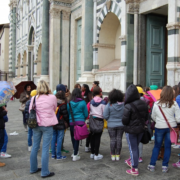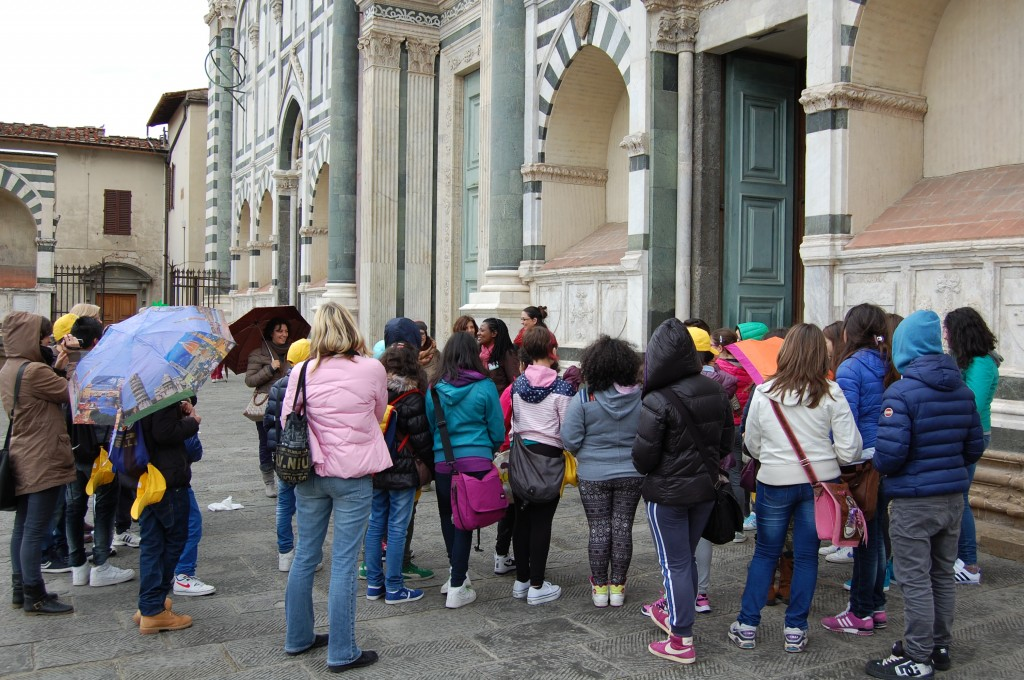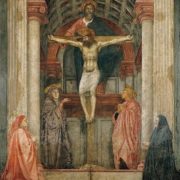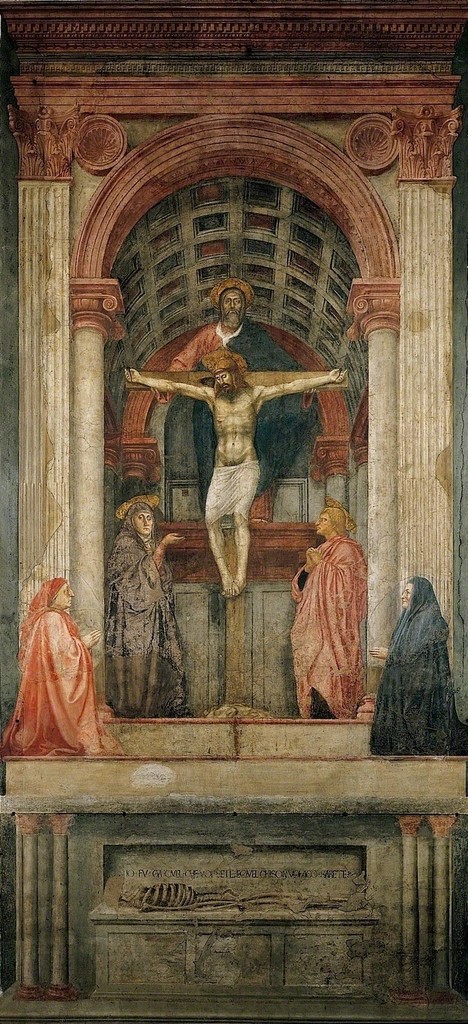The National Gallery and Masaccio
Masaccio was the first truly Renaissance artist who, in his short lifetime of 26 years of which perhaps only five were as an independent master, managed to revolutionize Western painting.
He was born in 1401 and in honor of his 600th anniversary, a few relatively modest events are being planned for his birthplace of San Giovanni Valdarno, which does not possess a single work by their local hero. London’s National Gallery has scheduled a far more ambitious event. The Gallery owns the enthroned Madonna and Child which originated as the central section of the altarpiece for the Carmine Church in Pisa. This painting, really a large fragment of the whole, is well documented as having been executed for the chapel of a wealthy notary, Giuliano di Colino degli Scarsi, during the calendar year 1426. It forms one of the very few fixed points in the short career of the master and the entire Renaissance, for that matter.
The altarpiece was a highly complex structure composed of a predella, the broad and rather large central panel including four standing saints, smaller ones set into pilasters (?), half-length saints, and other representations at the uppermost zone. In the later 16th Century Masaccio’s polyptych was removed from the chapel, which was located on the tramezzo and which was demolished. At some point, presumably shortly thereafter, altarpiece was cut up. In the process the four side saints, two on either side of the enthroned Madonna, including the patron saint of the donor and that of his father (Colino=Niccolò), were separated and have disappeared. Other losses include smaller sections, and possibly a strip at the bottom of the Madonna panel which, in turn, was very severely cleaned in the more distant past. In other words what is left of the original painting is highly fragmentary. To be sure, theoretical reconstructions have been offered from time to time by art scholars, but none have received the full support of their colleagues. One of the complicating factors is that the design of the pala was still in the late Gothic style and was created not by Masaccio but by a Sienese carpenter.
In addition to the marvelous Madonna, which was purchased by the National Gallery in 1916, other smaller panels known to have formed part of the altarpiece are found in public collections in Los Angeles, Berlin, Pisa and Naples. The National Gallery has announced that all of the known parts, eleven including their own, will be brought together for an exhibition in London from September 12 to November 11. As a parenthesis, I cannot hide my puzzlement that the National Gallery does not keep it open until Masaccio’s actual birthday on December 21st. Perhaps it doesn’t fit into the Gallery’s plans for the Christmas show.
On its face, the proposal to bring together these sections seems reasonable enough. But upon reflection serious doubts are raised concerning the use of the world’s artistic heritage by this newsworthy exhibition.
The goal seems to be to bring the “masterpiece back to life” [Daily Telegraph, 12 July 2001], that is to “attempt to reconstruct” the polyptych. According to the Gallery itself, however, what will be presented probably amounts to “only a third of the original work.” So if the goal is as stated – and what else could it possibly be? – it is a flawed one. Besides, one of the fundamental issues for any reconstruction of the altarpiece is the very nature and appearance of the frame and how the different extant sections relate to it and to one another. The frame, however, has totally disappeared without any meaningful clues as to its original appearance. In other words the very objective of the exhibition is really an impossibility to start with, and the promised conferences of art historians cannot change the situation.
Perhaps the hidden agenda may instead involve public relations, which has become part of the museum’s modus operandi anyway. By showing how clever they are in bringing these rare objects together, the National Gallery apparently can expect to accrue valuable publicity. This objective is hardly unique to the National Gallery, but it is exceptionally adept at this kind of activity, more so than the Met or the Washington National Gallery. And, of course, the thought that these works will be brought together from far-flung places is pleasant enough. The handful of specialists who might be interested and understand the nuances of the situation should be contented. After all, I recall a difficult winter day in Berlin when I went to specifically to see the seven sections of the Masaccio altarpiece there, several of which are actually autograph, that is, by the master himself: the others are by his workshop.
Still, shipping works around the world should give one pause. It can be dangerous for at least three reasons: (1) there is always the possibility of an accident, either from a plane crash, a boat sinking, truck accidents, dropping, or the like, and not even Dr. Neil McGregor, the National’s skillful Director, with all his power, could prevent such an occurrence; (2) the changes in the natural or acquired environments of delicate works of art inevitably involves some risk, all the more so in the case of paintings on prepared wood panels. This despite all of the preparations and special containers with constant humidity. How this condition compares with the location in their “homes” in Berlin and Naples is quite another matter. Besides according to reliable reports from scientific institutes, the shipment of art works, no matter how carefully executed, is damaging: it is merely a question of how much damage occurs; (3) very often in exhibitions such as this one, special treatment for the paintings is required to help them sustain the trip, treatments which often include unnecessary and frequently misleading restorations.
If I have lined up some of the negatives for the presentation of the exhibition, perhaps we might try to present positives: (1) you could hope to bring more people to the National Gallery to view and appreciate art than might otherwise have come. Of course, while specialists are very keen on Masaccio, the rest of the population probably does not even recognize his name, or retains but a faint memory from an Art Appreciation course in college. It will not be a door buster, and cannot be expected to provide the opportunity to sell a lot of catalogues at the book shop, or generate much needed cash for the Gallery. (2) By bringing these parts together, Masaccio specialists may be aided in their ongoing efforts to determine the authorship of the various parts, separating the hand of the master from that of his workshop, a fairly esoteric activity which could also be done without shipping the objects. (3) There is a publicity value in showing the Museum to be active on an international scale, and thus an institution to admire and support financially.
A very simple, inexpensive, and secure alternative to the National Gallery’s initiative for Masaccio is readily available, and ArtWatch International has urged the Getty Museum in Los Angeles, the Berlin Museum, and the National Museums in Pisa and Naples to consider it. They should send high-quality scale facsimiles of their treasures and keep the originals in their proper and safe place. The goals of a pseudo-reconstruction and comparison between the works can be obtained just the same. One is quite able to study and reconstruct to one’s heart’s content without any danger to the rare originals, especially, I must single out, the Adoration of the Magi in Berlin, a tiny masterpiece in quite good condition which ranks with the best pictures of the Fifteenth Century, and the Crucifixion in Naples, another gem, although it has undergone considerable modern restorations. Nevertheless it is a work of the most rare beauty. And if, Heaven forbid, an accident should occur, the reproductions would be lost and could be easily replaced, but the originals would still be there in Stiftung Preussischer Kulturbesitz Gemäldegalerie and in the Capodimonte, where they belong. The fact is that Dr. McGregor himself has stated that it took two years to persuade the other institutions to lend their works. Sometimes even governments get involved in the persuasion efforts or alternatively a borrowing institution coaxes the potential lender by promises of sending them a prestigious work in the future.
To return to the larger issue of the treatment of our treasures, I suggest that the Crucifixion exhibition is basically one which is motivated by efforts to gain prestige for the institution and consequently to reap rewards. This condition is similar to more ambitious blockbuster exhibitions which are held in large and small museums alike with some regularity all over the world and which involve the sending of objects hither and yon. At its core, the problem presents a dilemma. The commercialization of the museum in the West with its explosive museum stores selling every conceivable object, hiring vast fund raising and press relations staffs, and using all of the sophisticated tricks of advanced public relations to make their point involves an obvious rationalization: these are wonderful institutions of culture, they offer wide public access to works of art and a certain amount of instruction on how to understand the art, and they are the objective of “cultural” tourism. They are in constant need of funds to carry out their good work.
So what is really wrong with selling Matisse ties or Michelangelo mouse pads, where the poor little critters get stuck forever on a glue mat showing God creating Adam. It’s fun, it’s practical, it helps the institution. Why fuss? So what if the Metropolitan Museum has fifteen Museum shops, located from California and Texas to Florida? They contribute to the needs of the Museum and even provide work for artisans and middlemen. And if they have fifteen, why not twenty? And what is to stop the Louvre from doing the same, and the Uffizi, and the Prado? And what is wrong with the restoration, unnecessary in the view of Italy’s new Under-secretary of Fine Arts (and my own), of Michelangelo’s Moses, shown on-line, where you can play Moses games? What is wrong with having restaurants all over the Museum of Modern Art, or renting out the main hall of the Metropolitan or the Uffizi for a fashion show or a wedding reception? For many, there is nothing wrong; in fact, it is a pretty good thing, for in this way the institutions become self-sufficient and do not need government support. The issue is a lingering one and requires long and careful debate. It should become one of the crucial issues which the culture will have to face full-front in the coming years.





